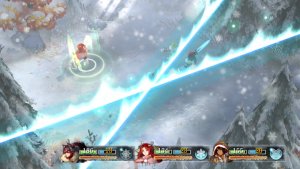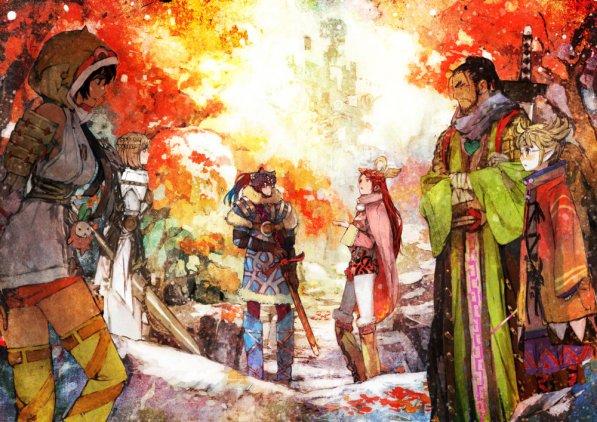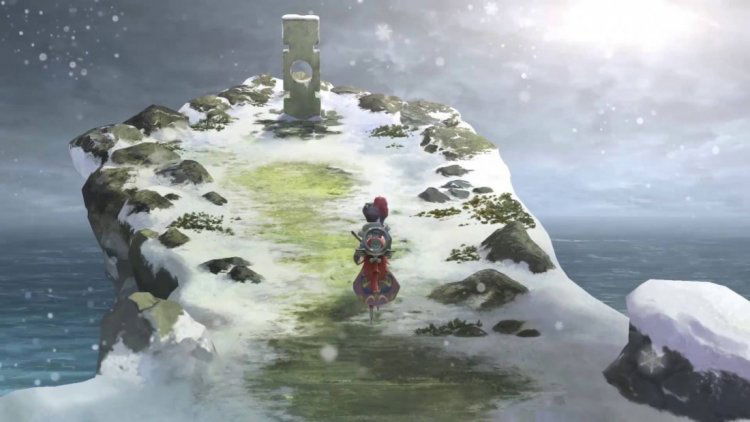I Am Setsuna, released last July on PS4 and Steam, is the first RPG to land on the Nintendo Switch. Tokyo RPG Factory’s goal for Setsuna was to recapture the magic of the 90s RPG. I’m glad to report that, for the most part, they hit the mark. Still, I Am Setsuna has some undeniable flaws in the story, pacing, and combat that prevent the game from entering the top class of Square Enix RPGs.
Game Name: I Am Setsuna
Platform: Nintendo Switch
Publisher: Square Enix
Developer: Toyko RPG Factory
Release Date: 3/3/2017
Price: $39.99
Story: A Tale of Inevitability, Loss, and Hope
I Am Setsuna opens by introducing the player to one of the story’s deuteragonists, Endir. The masked mercenary dispatches monsters in a beautiful snowy forest before being tasked by a mysterious man to murder a girl set to become a sacrifice. He meets a selfless and gentle girl named Setsuna, the sacrifice, and joins her on her quest to protect the people of the realm.
Right away the game’s plot gripped me. The story is presented in a somber, yet peaceful, manner right from the get-go. It’s clear from the second Endir steps off the boat on Nive Island that this is a deep world with a lot of lore. Unfortunately, I Am Setsuna never really capitalizes on this strong foundation. There are so many questions I wanted answered: Why does the sacrifice always come from Nive? Why is Setsuna’s family always the one offering up sacrifices? Are all the towns connected or are they isolationist? I wanted to know more about this world. The foundation is there and captivating, but the plot never really reveals much about this snow covered world outside of what is necessary for its characters to grow.
The cast that joins Endir on his journey are pretty likable, but nothing special. I immediately felt a connection with Setsuna and Nidr, a traveler who joins the party in the early game. Kir, Julienne and Aeterna all join the party in unique ways but quickly became disinteresting. I really wanted to love Julienne, the princess of a fallen kingdom, but didn’t feel the game adequately explored her character.
This is all by design, for the most part, mind you. Tokyo RPG Factory wanted to make a game that felt like a 90s RPG, where character studies weren’t as possible due to the available technology. And the game does do a great job of making you feel like your entire party has a purpose for being on the journey. Every character has unique motivations for joining Setsuna’s guard, and everyone contributed to the party’s success. I just wish there was more meat on the bones character-wise.
The narrative itself is definitely strong. Everything adds up once the story reaches its satisfying conclusion, and I found it hard to restrain myself from googling what happens next when I needed a break from playing. Still, the game’s middle act definitely wore on me. Without specific spoilers, I found myself incredibly frustrated by Setsuna’s behavior and my inability as the player to influence the game’s events. Setsuna never wanted to fight even the most vile of monsters, and she makes it clear about 100 times throughout the 30 hour campaign. In one instance, I felt the best decision was to kill a weakened foe, but Setsuna forced me not to. Of course, the enemy regained his strength and tried to kill me again in an obvious turn of events. Once you reach the final act, however, the story picks up and hits all the right notes.
Gameplay: Traditional to a Fault
Tokyo RPG Factory succeeded in its goal of making an old-school feeling RPG. Inherently, however, that makes the gameplay flawed. Fortunately, moving around in the world makes for a great experience. When wandering the cold and lonely landscapes, two party members follow the party leader controlled by the player. There’s a huge overworld hub that you can quickly navigate to move from town to town, and plenty of icy caverns and nearly impassable mountains to explore. I can’t think of an overworld as engrossing as Setsuna‘s. It’s barren, quiet and cold… so cold that the player can feel it. Peaceful piano music plays as you travel the land, and I’d find myself reflecting on both the game and my own life while exploring.
Unfortunately, Setsuna often shakes the players out of those enchanted states by removing them from the game’s world. This happens in both dialogue and in combat. Endir serves as the player’s voice, but his dialogue options never result in any meaningful change to the story. Usually, only the first ensuing line of dialogue is altered from the options given. By the end of my journey, I was just clicking A on an option without even reading it.

These combo moves are silly broken, and stand out as the worst part of I Am Setsuna. They remove the need to mix up your party, because certain technique(s) are simply absurdly strong. I put parenthesizes around the “s” because I only used one attack for about half the game. Endir and Nidr learn the combo “Blowbeat”, which literally will one hit kill every single normal enemy throughout the entire game. In the last dungeon I’d use Blowbeat against four dragons at once and kill them in about 3 seconds. While the cost of magic for this move was high, I’d just have Setsuna cast “Prayer” to refill both their meters at once and repeat the process.
I get that I played this way by choice, but there’s more to it than that. The game actively encourages you to play this way. You receive additional items for defeating enemies with certain techniques. Usually, I’d get the “exact kill” or “momentum kill” bonuses, but with Blowbeat, I’d get “Linked Kill” “Momentum Kill” “Overkill” and “Light Kill” every time. I’d get over 100 item drops each battle using this extremely simple strategy.
If combat is the worst part of Setsuna, the most frustrating part is the game’s lack of autosave. Setsuna is by no means difficult, but odds are you will die a few times on your journey. If that’s the case, you’d better remember to save constantly on the world map. I forgot to a few times and the result was easily four hours of lost game time. Players can’t save anywhere they like, you see. They can only do that on the world map. You need to find save spots when traversing dungeons if you want to save your game, and those are often extremely far apart.
Again, this wouldn’t be so bad if player’s deaths were always warranted. But they’re not. Two of my deaths and hours of lost gameplay came by stumbling upon a standard looking enemy only to find that it was actually a super monster. These are high-level foes the game expects you to defeat only when prepared, and you receive no warning about what you’re getting yourself into. Twice I was killed in about two seconds by these monsters, losing hours of gameplay in the process. You can’t run away in battle without an item to do so, so if you stumble into one of these situations, you’re basically screwed.
Presentation: The Ultimate Winter Wonderland
There’s nothing but cold settings in I Am Setsuna, and that’s perfectly okay. In fact, it’s magical. This game’s visuals are the best of an RPG I have ever played. Snow constantly falls in front of the screen, obscuring the player’s view just enough to make them feel like they are a part of the world around them. A gentle piano score captures the emotions of every moment, ranging from ominous to pleasant to uncomfortably sorrowful. I’ve spent each night since I began my journey with Setsuna listening to the soundtrack before bed. Composer Tomoki Miyoshi deserves endless praise for his beautiful work.
https://youtu.be/CrJgIrsqumE
The characters appearances capture the feeling of an old school RPG while also looking fresh, and each town is just distinctive enough to stand out from the last. Truthfully, the visuals in I Am Setsuna tell the story better than the narrative itself. Every home is dimly lit and peaceful. You’ll find yourself wanting to just plop down by the fire and take a long, warm nap. Caverns look like crystal palaces, conveying the beauty of the cruel world you’re exploring. Rivers give off a little shine as the sun reflects along the water, and trees drop snow in the wind. I can’t stress enough how perfect the visuals are. They’re easily Tokyo RPG Factory’s greatest accomplishment in Setsuna.
Conclusion
I Am Setsuna is definitely worth your time if you’re an RPG fan looking for something to play on Switch. It’s environments and musical score overcomes the game’s other deficiencies and make it stand out as a unique RPG experience. Setsuna doesn’t take too many chances, but that’s perfectly okay. If you are a fan of turn-based RPGs, there’s a lot to like here. If not, I’d recommend Shovel Knight or SnipperClips to resolve your post-Zelda hangover.
Summary
I Am Setsuna’s 30 hour campaign is filled with highs and lows. It drags a bit in the middle, but an emotional ending makes seeing this journey through absolutely worth it. If you like turn based RPGs, there’s not a doubt in my mind you’ll enjoy Setsuna. If not, this one won’t change your mind.
-
A poor combat system isn't enough to stop I Am Setsuna from being a worthy RPG for Switch



